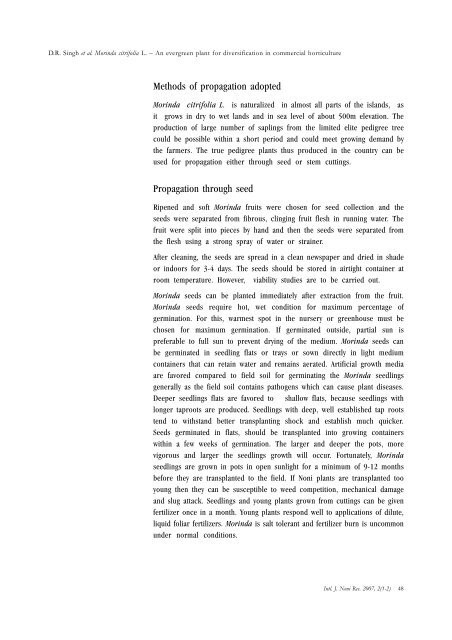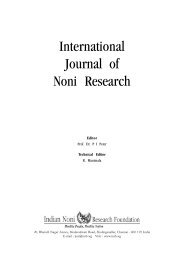International Journal of Noni Research - Noni Family
International Journal of Noni Research - Noni Family
International Journal of Noni Research - Noni Family
You also want an ePaper? Increase the reach of your titles
YUMPU automatically turns print PDFs into web optimized ePapers that Google loves.
D.R. Singh et al. Morinda citrifolia L. – An evergreen plant for diversification in commercial horticulture<br />
Methods <strong>of</strong> propagation adopted<br />
Morinda citrifolia L. is naturalized in almost all parts <strong>of</strong> the islands, as<br />
it grows in dry to wet lands and in sea level <strong>of</strong> about 500m elevation. The<br />
production <strong>of</strong> large number <strong>of</strong> saplings from the limited elite pedigree tree<br />
could be possible within a short period and could meet growing demand by<br />
the farmers. The true pedigree plants thus produced in the country can be<br />
used for propagation either through seed or stem cuttings.<br />
Propagation through seed<br />
Ripened and s<strong>of</strong>t Morinda fruits were chosen for seed collection and the<br />
seeds were separated from fibrous, clinging fruit flesh in running water. The<br />
fruit were split into pieces by hand and then the seeds were separated from<br />
the flesh using a strong spray <strong>of</strong> water or strainer.<br />
After cleaning, the seeds are spread in a clean newspaper and dried in shade<br />
or indoors for 3-4 days. The seeds should be stored in airtight container at<br />
room temperature. However, viability studies are to be carried out.<br />
Morinda seeds can be planted immediately after extraction from the fruit.<br />
Morinda seeds require hot, wet condition for maximum percentage <strong>of</strong><br />
germination. For this, warmest spot in the nursery or greenhouse must be<br />
chosen for maximum germination. If germinated outside, partial sun is<br />
preferable to full sun to prevent drying <strong>of</strong> the medium. Morinda seeds can<br />
be germinated in seedling flats or trays or sown directly in light medium<br />
containers that can retain water and remains aerated. Artificial growth media<br />
are favored compared to field soil for germinating the Morinda seedlings<br />
generally as the field soil contains pathogens which can cause plant diseases.<br />
Deeper seedlings flats are favored to shallow flats, because seedlings with<br />
longer taproots are produced. Seedlings with deep, well established tap roots<br />
tend to withstand better transplanting shock and establish much quicker.<br />
Seeds germinated in flats, should be transplanted into growing containers<br />
within a few weeks <strong>of</strong> germination. The larger and deeper the pots, more<br />
vigorous and larger the seedlings growth will occur. Fortunately, Morinda<br />
seedlings are grown in pots in open sunlight for a minimum <strong>of</strong> 9-12 months<br />
before they are transplanted to the field. If <strong>Noni</strong> plants are transplanted too<br />
young then they can be susceptible to weed competition, mechanical damage<br />
and slug attack. Seedlings and young plants grown from cuttings can be given<br />
fertilizer once in a month. Young plants respond well to applications <strong>of</strong> dilute,<br />
liquid foliar fertilizers. Morinda is salt tolerant and fertilizer burn is uncommon<br />
under normal conditions.<br />
Intl. J. <strong>Noni</strong> Res. 2007, 2(1-2) 48








